Amnesty has called on the Iranian government to 'immediately and unconditionally' release a woman arrested for taking off her headscarf in public to protest the Islamic dress code enforced on women.
The unnamed woman was filmed standing on a pillar box in central Tehran, waving a white hijab in the air, in a video which later went viral.
Witnesses say the woman, a 31-year-old mother-of-one, was arrested shortly afterwards and has not been seen since.
The human rights organization said in a statement to MailOnline that 'Iranian authorities must immediately and unconditionally' release her, describing her actions as 'engaging in a peaceful protest against compulsory veiling (hijab)'.

Missing: The mystery woman (pictured) was praised after a video of her waving her hijab in protest went viral on social media, but she was reportedly arrested shortly afterwards
Three eyewitnesses reported to Amnesty International that law enforcement officials arrested the woman on the spot, and transferred her to a nearby detention centre known as Kalantari 148.
No information about her fate and whereabouts has since been made available publicly, sparking fears about her safety and well-being.
Thousands of social media users have shared messages of support, dubbing her the 'Girl of Enghelab Street' after the area in central Tehran where she staged the protest.
A social media campaign using the hashtag #WhereIsShe has now gone global, with activists calling on the United Nations to get involved and take the Iranian government to task and force them to reveal what happened to her.
Nasrin Sotoudeh, a renowned human rights lawyer, has taken it upon herself to investigate the disappearance, and said she is certain the woman is in custody.
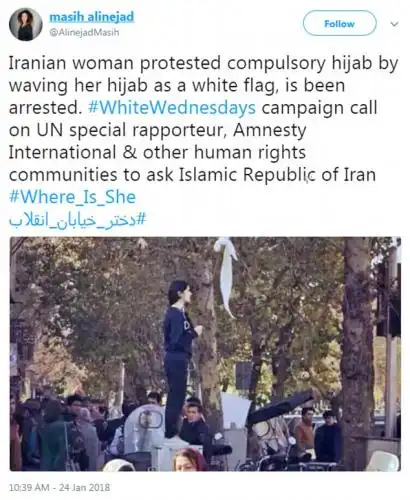
Call for aid: Journalist Masih Alinejad called for UN and Amnesty to put pressure on the Iranian government to reveal what happened to the protester

Join the force: After initially being shared by human rights campaigners in Iran, the fight to find out the fate of the Girl of Enghelab Street has gone global

Support: Two participants in the Women's March in Boston, US hold up placards with the campaign slogan
Ms Sotoudeh said she could not find out the woman's name, but had been told she was 31 years of age, and had a 19-month-old baby.
'What I am certain about is that this lady has been arrested,' she told AFP.
'The witnesses on the scene who saw her being taken away and even accompanied her to the police station gave me this information. I have no contact with her family.'
The woman was protesting Iran's Islamic legal code, which requires women to wear a headscarf and long clothes that cover the arms and legs.
Breaking the rules can bring fines of up to 500,000 rials ($12) and up to two months in prison.
Ms Sotoudeh claims that police of frequently go beyond what is punishable by law for not wearing a headscarf.

Not covering your hair in public is a punishable offense for Iranian women, and the unnamed protester, dubbed 'Girl of Enghelab Street' is believed to still be in custody
She said: 'Before even being tried by legal authorities, (women) are taken to a place called 'Gasht-e Ershad' [Guidance Patrol], where they can be harshly beaten up. Whether a case is opened for them or not is not important.
'The illegal punishment they have had to bear has always been much more than what is foreseen in the law.'
President Hassan Rouhani, who came to power in 2013 promising a more moderate stance, has previously said it is not the job of police to enforce religious rules.
But in April 2016, officials said there were 7,000 undercover morality police reporting on things like 'bad hijab'a blanket term usually referring to un-Islamic dress by women.
The Girl of Enghelab Street: What she stood for
The unnamed woman who took her hijab off in public and waved it like a white flag in central Tehran, was protesting the Islamic dress code enforced on women in Iran.
The woman, reportedly a 31-year-old mother, broke the law by exposing her hair in public, risking arrest and fines.
The Girl of Enghelab Street, nicknamed so because of the name of the road where she took her head-scarf off in protest, has spurred many other women in Iran to do the same.
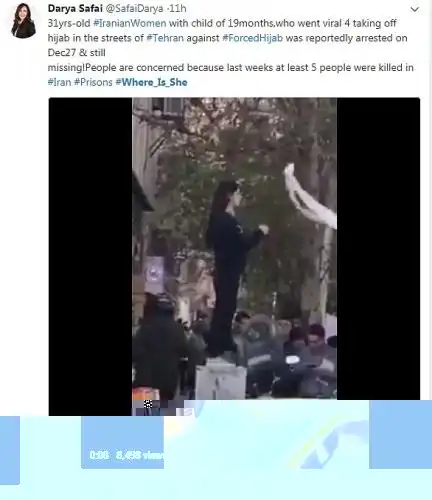
Missing: The unnamed woman was taking part in a women's movement called White Wednesdays, which protests the enforcing of strict Islamic dress codes in Iran
Since her protest on December 27, she has become a symbol for Iranian women's fight against compulsory hijab, with many sharing the video of her protest on social media and illustrations of her brave stand.
She has become the 'poster child' for the White Wednesdays movement, which encourages Iranian women and those who support their plight to take off their hijab, and was started by journalist and campaigner Masih Alinejad.
White is one of the most common colours of headscarves in Iran, which only allows 'modest' shades such as white, brown or black.
Another campaign fighting against the enforced hijab in Iran set up by Ms Alinejad is My Stealthy Freedom.
It is 'dedicated to Iranian women inside the country who want to share their “stealthily” taken photos without the veil', and aim to be a 'living archive' of their fight.
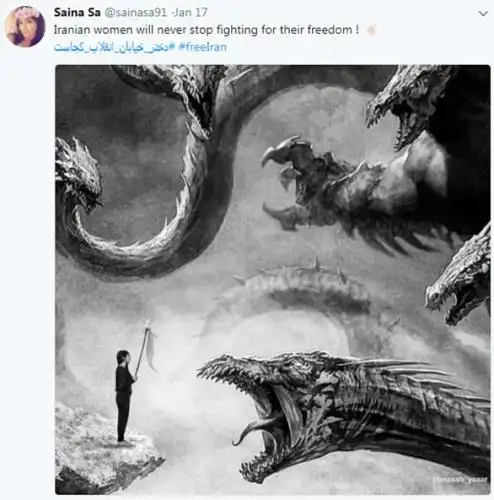
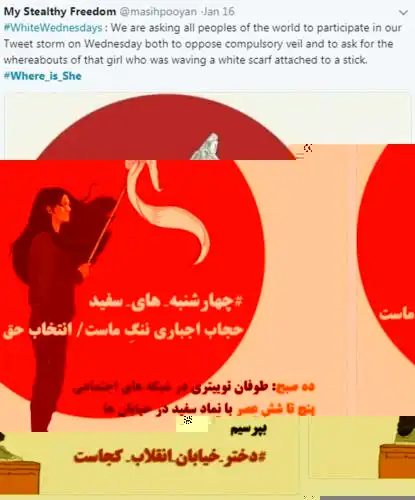
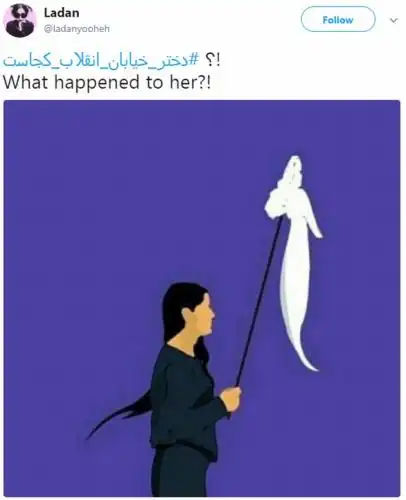
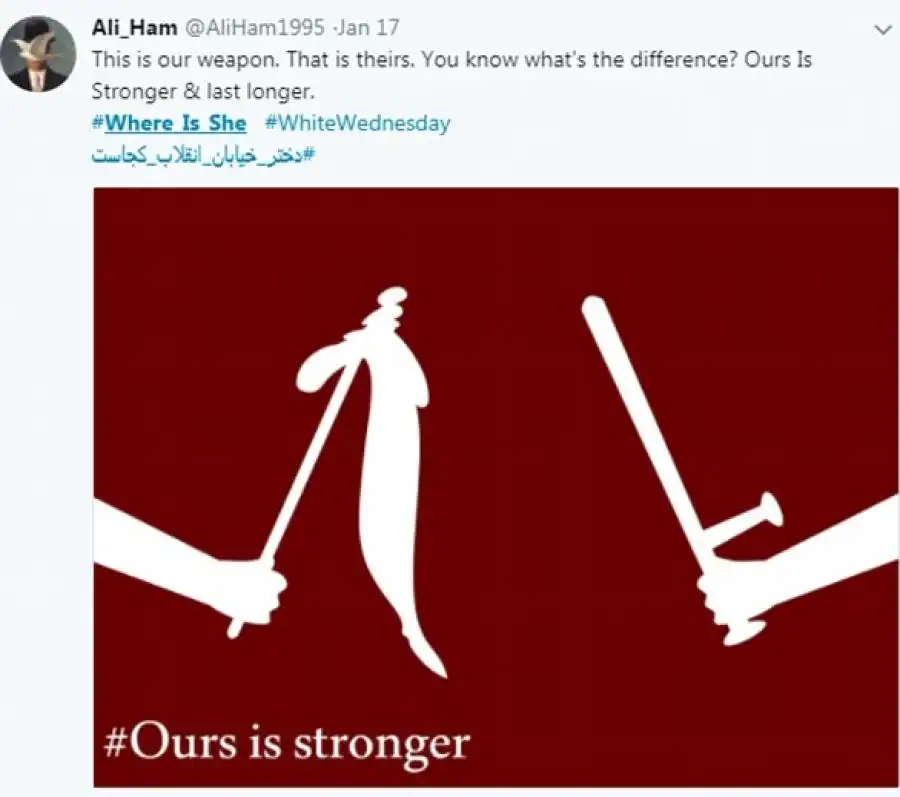
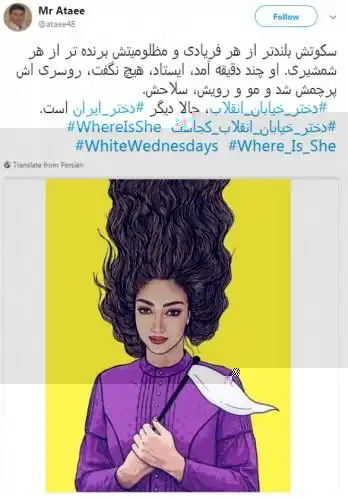


Movement: Supporters have been sharing graphic illustrations of the Girl of Enghelab Street, painting a picture of her as an iconic fighter for women's rights in Iran
It sees women post 'stealth' photos or videos of themselves where they have dared to take off their hijab, to spread the message and protest.
Some women film themselves walking down public streets without their headscarf to show to the world the amount of abuse they face if they dare show their hair.
Since the 1979 revolution, Iran has required women to wear the Islamic headscarf in public.
The Islamic code also forbids women touching, dancing or singing with men outside their families.
Women are only allowed to show their face, hands and feet in public and are supposed to wear only modest colours.

Leader: The Girl of Enghelab Street is being depicted as Moses in the Bible, parting the Red Sea

This image shared on social media shows a person in an unknown location having built a snow statue of the Girl of Enghelab Street